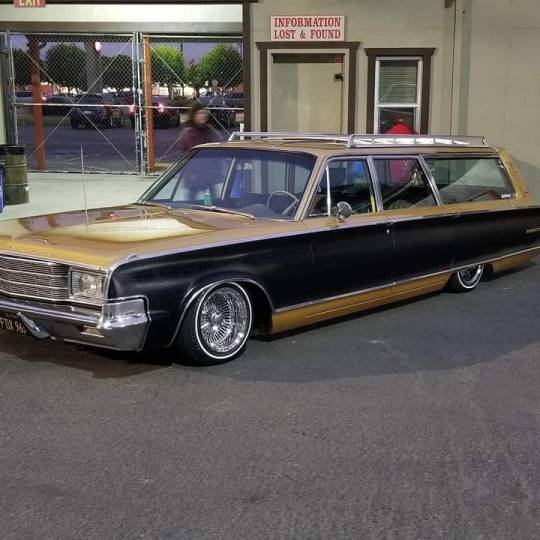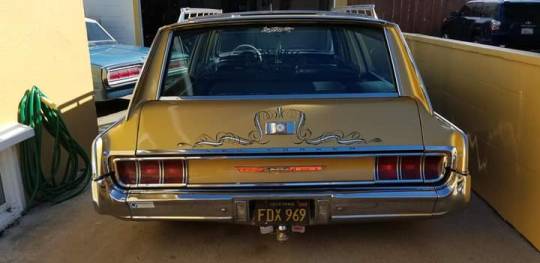#longroof
Text


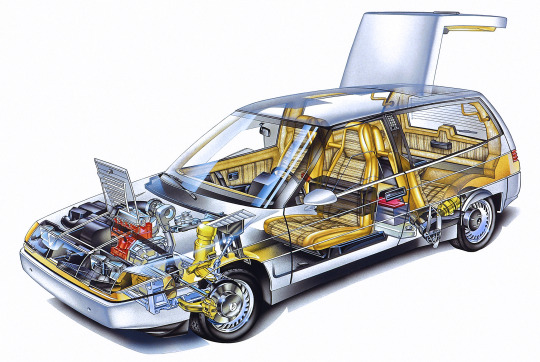
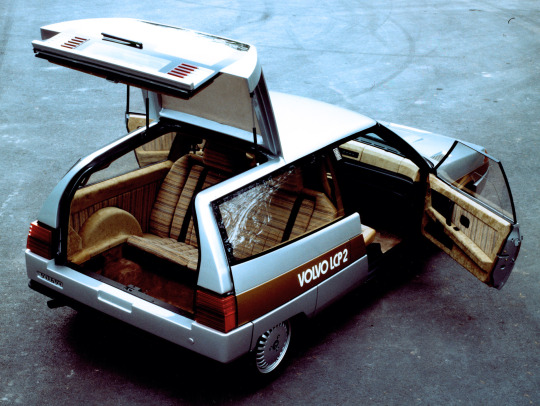

40 years ago the future looked like this Volvo LCP 2000, 1983. A concept that projected what a car from the year 2000 might look like. LCP is an abbreviation for Light Component Project, the car weighed less than 680 kg (1,500lb) thanks to the use of magnesium and plastics
#Volvo#Volvo LCP 2000#concept#design study#futuristic#1983#40 years ago the future looked like this#lightweight#prototype#longroof
251 notes
·
View notes
Text
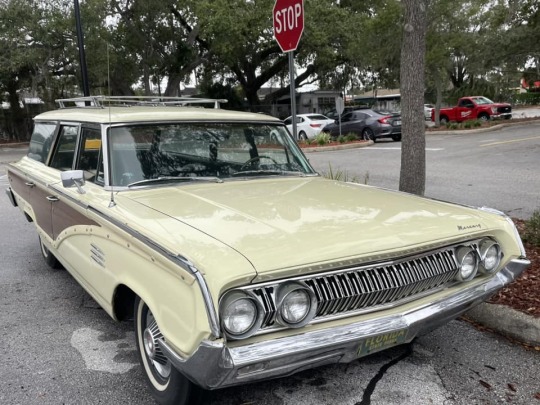
1964 Mercury Colony Park
5 notes
·
View notes
Text
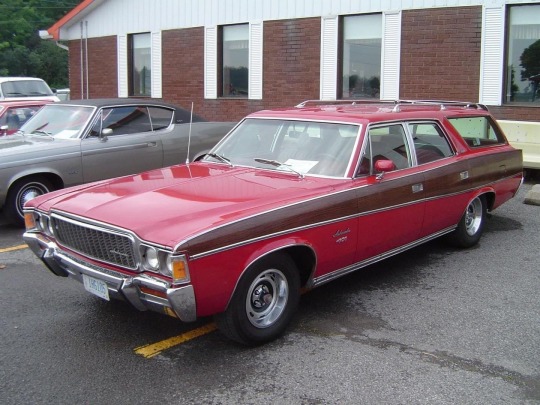
1972 AMC Ambassador wagon
63 notes
·
View notes
Photo
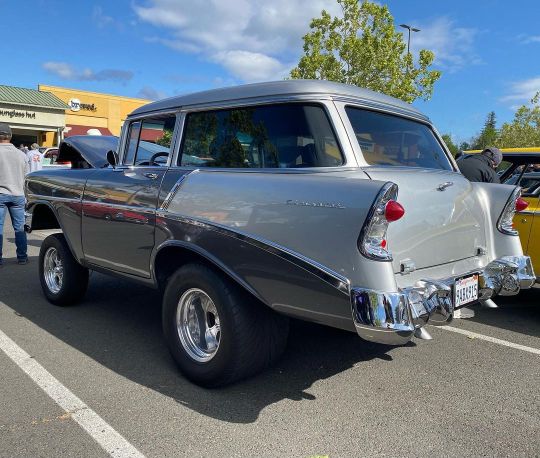
Coming up short….But long on looks. 👀 This ‘56 Chevy was shortened and finished to a high quality. #inthegaragewithstevenatale #longroofsociety #longroof #56chevy #1956chevy #1956chevrolet #stationwagon #napacarsncoffee #napacarsncoffee (at Napa, California) https://www.instagram.com/p/Cd3ObncrUyI/?igshid=NGJjMDIxMWI=
#inthegaragewithstevenatale#longroofsociety#longroof#56chevy#1956chevy#1956chevrolet#stationwagon#napacarsncoffee
6 notes
·
View notes
Photo
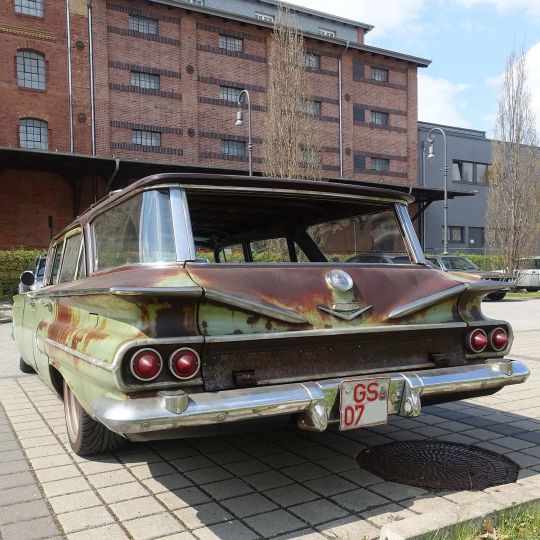
1960 Chevrolet Kingswood at Kaffee & Karossen at the @ps.speicher in Einbeck in April. The May edition of Kaffee & Karossen will take place on Sunday. #wagonwednesday #kaffeeundkarossen #PSSpeicher #60ChevyKingswood #60chevy #ChevroletKingswood #1960chevy #classicchevy #ChevyKingswood #1960ChevyKingswood #chevylife #chevynation #chevymusclecar #longroof #wagonlove #uscar #americancar #classiccarspotting #vintagecarspotting #teilixchevrolet #CarPhotography #classiccaroftheday #classiccarsdaily #oldtimer #classiccar #vintagecar #automotivephotography #patinaperfection (hier: PS SPEICHER) https://www.instagram.com/p/Cda6TCGoAzi/?igshid=NGJjMDIxMWI=
#wagonwednesday#kaffeeundkarossen#psspeicher#60chevykingswood#60chevy#chevroletkingswood#1960chevy#classicchevy#chevykingswood#1960chevykingswood#chevylife#chevynation#chevymusclecar#longroof#wagonlove#uscar#americancar#classiccarspotting#vintagecarspotting#teilixchevrolet#carphotography#classiccaroftheday#classiccarsdaily#oldtimer#classiccar#vintagecar#automotivephotography#patinaperfection
2 notes
·
View notes
Photo

Lit with friends 🚥💁🏼♂️🚥 · Mo' lights [*Shades required, even during daylight hours…😂] #strandslightingdivision #pelican #builttoprotect #pelicanlife #frontrunneroutfitters #findanywhere #tron #pelicancase #minecraftbuilds #allterrain #audioffroad #fifteen52 #bfgko2 #audi #allroad #quattro #wagonation #campallroad #zrdrk30 #longroof #wagonlife #avantlife #wagonlove #wagonestate #audigramm #audiquattro #audipixs #frontendfriday #ZeroDarkThirty (at Zee MineCraft) https://www.instagram.com/p/CjLeGcXJla6/?igshid=NGJjMDIxMWI=
#strandslightingdivision#pelican#builttoprotect#pelicanlife#frontrunneroutfitters#findanywhere#tron#pelicancase#minecraftbuilds#allterrain#audioffroad#fifteen52#bfgko2#audi#allroad#quattro#wagonation#campallroad#zrdrk30#longroof#wagonlife#avantlife#wagonlove#wagonestate#audigramm#audiquattro#audipixs#frontendfriday#zerodarkthirty
0 notes
Text

1937 Hispano-Suiza K6, complete with an original, one-of-one woody wagon body by Franay.
Technically, it’s not a “wagon” but a “Break De Chasse,” which is French for “Shooting Brake,” and no doubt it was intended as a utility for hunting and other activities. There might be more opulent longroofs, but you’d probably have to go to the Sultan of Brunei’s warehouse to find them. Instead, we went to the Mullin Museum last week.
Somewhat ironically, the K6 was actually a simplified lower-end model when it was new, as the French side of the company was struggling in the mid-1930s with a bunch of amazingly exotic cars that very few people could afford, but all Hispanos are serious exotica today, and 1937 was the last full year of production at Bois-Colombes before the French side became strictly an aero-engine company, though the Spanish side continued on longer.
While cars like this are still blue-chip collector cars and probably always will be, there isn’t as much interest in pre-war exotics as there once was. Their stories are still worth telling, however, and this Hispano is still a work of art.
Though often thought of as a French automaker, and this K6 was built in France, Hispano-Suiza means “Spanish-Swiss,” and was founded in Barcelona by Swiss engineer Marc Birkigt, along with financial manager Damián Mateu in 1904. Born in Geneva in 1878, Birkigt was mechanically gifted from an early age and graduated from engineering school in 1898, briefly working in the watch trade and a gunsmith during his military service, but it was railways and electric locomotive work that brought him to Spain.
Hispano-Suiza was an outgrowth of two earlier, failed ventures Birkigt had worked for. The first was an electric vehicle company, La Cuadra, that wanted to make an electric bus, later followed by a two-cylinder, Panhard-like car. When that failed the company was taken over by José María Castro Fernández, who took over and had Birkigt engineer another car, the four-cylinder Castro, only for his finances to fail and the firm become as Hispano-Suiza in June 1904.
Birkigt was an engineer on par with Frederick Henry Royce, and the early Hispanos boasted lots of innovations, including combining the engine and gearbox into a structural unit that could add rigidity to the chassis, and they were well-liked. The company’s fortunes were greatly boosted when King Alfonso XIII bought a trio of 20-24 Tourers at the 1905 Barcelona show, and when Birkigt designed his first truly great sporting car in 1908, he returned the favor by naming the T-headed, high-revving monster the “Alfonso XIII.”
Royal patronage was great, but Spain was a poor country with terrible roads, and Hispanos were expensive cars. In 1911, the firm set up a satellite factory at Levallois-Perret in Paris and later moved to Bois-Colombes, with Birkigt soon taking up residence there. While the Alfonsos and other Hispano Suizas had lots of competition success, WW1 was spent mainly on aero engines, and Birkigt’s OHC airplane V8s were light, powerful, and durable, and their design later informed Hispano’s cars.
After the war, the ultimate Hispano-Suiza car, the H6, debuted in 1919. Production would last until 1933, although a few were finished in 1934 and, if you had enough money, you could buy one as a one-off even later.
With 6.6 or 8.0-liter straight sixes, the H6s were glamorous in the same way Isotta-Fraschinis were, but often much nicer to drive and far superior handlers thanks to their very rigid frame, friction dampers, and other advances. Hispano-Suiza was an early adopter of four-wheel brakes and brake boosters, and H6s could hit up to 85 mph. They were also beautiful, and when Harley Earl was tapped to design the 1927 LaSalle, he essentially copied the H6.
Over time, the Spanish and French factories, separated by management and geography, grew apart in ways that few modern concerns would. Barcelona often fielded a wider range of more humble products and also built lots of commercial trucks and wagons. Bois-Colombes built only the finest cars and aeronautical engines. In many cases, Spain built a design far longer than France would. Both were happy for the success of the H6, and there were many other types in the 1920s that came and went.
The depression threw a big monkey wrench into this situation just as Bois-Colombes was getting ready to launch the 54CV, 9.4-liter V-12-powered J12 in 1931. Although it had some lesser models, Hispano-Suiza’s French side was essentially all-in on top-tier luxury cars. In 1933 even the “Junior” chassis cost more than a fully-assembled Bugatti Type 57.
The K6, with a simple OHV 5.2-liter, ~120-hp straight-six, and 3-speeder with a dry-plate clutch, was created to offer something more affordable but preserve the quality and image that the H6 had so carefully cultivated. It could not reverse the economic tide for the company, but it did sell pretty well for a very expensive car during a time of economic calamity. Plus, it was well-made and nice to drive. Carrosserie Vanvooren provided the “off-the-rack” K6 bodies, but this was always a coachbuilt car.
While less expensive than the 220-hp J12s, the K6 was nevertheless a car for the privileged few. This one, chassis 15121, was first owned by Maurice Solvay, businessman grandson of Belgian chemist and inventor Ernest Solvay and husband of French actress Josette Day. By the time Solvay bought it, however, the end was near for the car line at Bois Colombes.
The Spanish Civil War threw that side of the company into chaos, though car production continued in Barcelona until 1943, while the French side was slyly taken over by the Government in 1937. They had it focus on aviation and defense contractor projects, and car production was wound down in 1938. The company continued as a defense contractor for another 30 years, but the two sides were permanently split.
Chassis 15121 was originally a cabriolet sedan, but in 1948 Solvay decided to turn it into a Break de Chasse, and turned to Franay, an old-line coachbuilder founded by former carriage interior maker Jean-Baptiste Franay in 1903 and later run by his son Marius.
Franay was one of many automotive ateliers in Levallois-Perret, the beating heart of France’s custom coachbuilding scene before WW2 and after (Chapron and Figoni et Falaschi were very nearby). While postwar Franay creations are usually pretty over the top like those of Saoutchik, the order here was functionality and beauty. Mission accomplished.
The car had a series of owners after Solvay’s death in 1960, including Renault designer Philippe Charbonneaux. It had a light restoration in the 1980s, and then a more comprehensive one when Peter Mullin bought the car in 2002, including replacing its Water Buffalo-hide interior
4 notes
·
View notes
Text
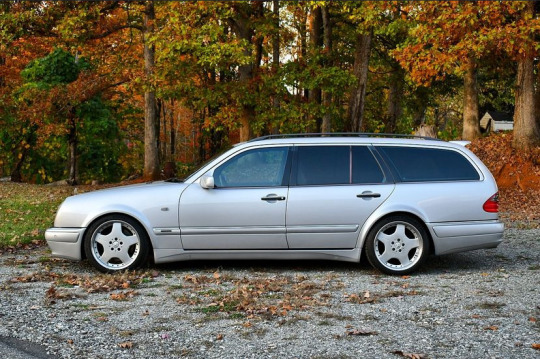


[e55 amg, longroof]
1 note
·
View note
Text




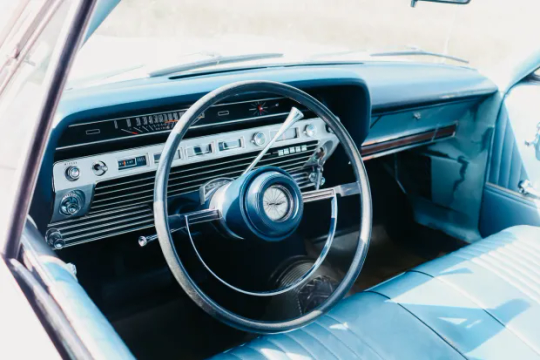

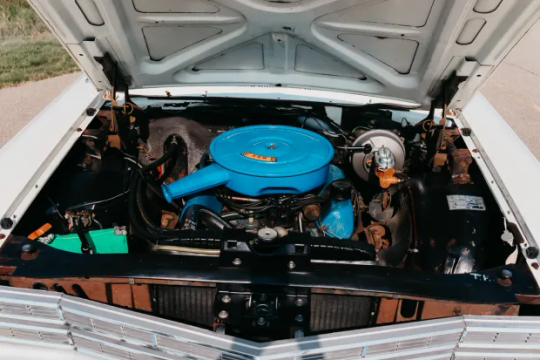

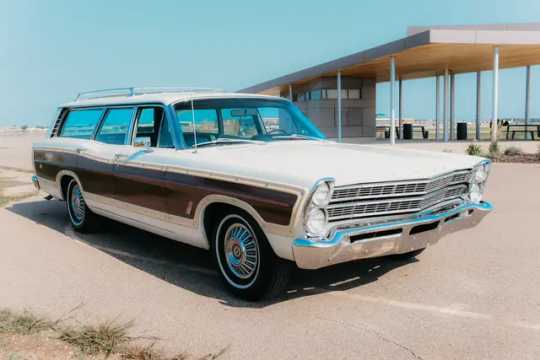
1967 Ford Country Squire
Off of Bring A Trailer. Very nice example with the relatively rare 428, I believe they were called ThunderJet. Nice colour combo, these would have often come with either a red, or a black interior, in those days you could choose from many options as far as colour combos go. Most of these would have come with a relatively gutless 390, gobs of torque but about 270 brake horsepower, so I'm going to guess well under 200 horsepower at the wheels. This one would be rated at about 345 BHP. Ford was loathe to install dual exhausts, or limited slip differentials in their cars in this era, and this one has neither. 1967 Big Fords came with two types of grills that look pretty much the same, the up market cars XL's, and LTD's had a diecast grill, all the others had a stamped aluminum one, this one looks to be the the diecast type. I believe these were the first Country Squires that came standard with power front disc brakes. This car sold for $25,250 which is really high for one of these, especially one with so few options. I love the longroofs, Country Squires especially.
0 notes
Text
Street Spot: 1958 Chevy Wagon
A regular feature here on Nostalgia Highway is the “Street Spot.” We love seeing vintage cars as daily drivers, out on the streets where they belong. When we see a vintage car worth sharing, we’ll post it as a Street Spot. Sometimes it will be a beauty, sometimes it will be a beater, but then again – even the beater cars are beautiful to us!
My buddy Darr sent me this cool 1958 Wagon he spotted rollin’ down the freeway. I do love a longroof and what a great stance as this beauty cruises down the road.
0 notes
Text
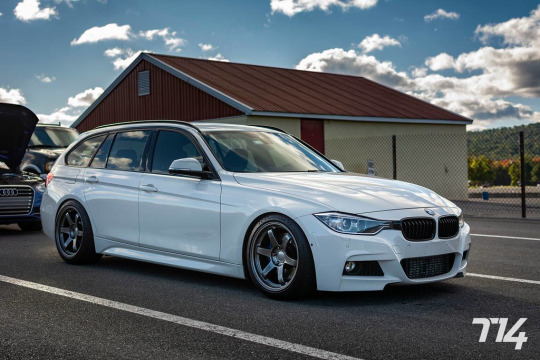

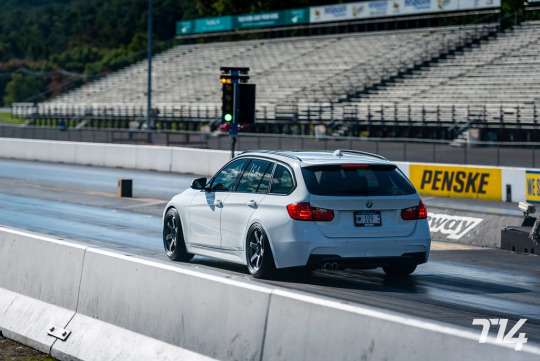
11 notes
·
View notes
Text

1971 AMC Ambassador Brougham station wagon
46 notes
·
View notes
Text
2024 Volvo XC40 Recharge Review, Pricing, and Specs
Overview
Remember these previous Volvo wagons with squared-off designs and utilitarian missions? Think of the 2024 XC40 Recharge as the fashionable interpretation of these brick-like longroofs, and we imply really fashionable. Underneath its stylish exterior the XC40 Recharge hides an all-electric powertrain making as much as 402 horsepower and boasting as much as 293 miles of estimated driving…

View On WordPress
0 notes

